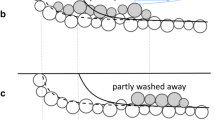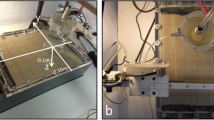Abstract
A method recently proposed for the computational modeling of backward erosion piping is applied for the numerical back-analysis of some pioneering experimental tests on physical models of cofferdams performed by Marsland (1953).
Access this chapter
Tax calculation will be finalised at checkout
Purchases are for personal use only
Similar content being viewed by others
References
Abati A, Callari C (2014) Finite element formulation of unilateral boundary conditions for unsaturated flow in porous continua. Water Resour. Res. 50:5114–5130. https://doi.org/10.1002/2013WR014693
Bauer GE, Scott JD, Shields DH, Wilson NE (1980) The hydraulic failure of a cofferdam. Can. Geotech. J. 17(4):574–583
Bonelli S, Brivois O (2008) The scaling law in the hole erosion test with a constant pressure drop. Int. J. Numer. Anal. Methods Geomech. 32:1573–1595. https://doi.org/10.1002/nag.683
BSI (2004) Eurocode 7: Geotechnical design - Part 1: General rules (BS EN 1997–1:2004). British standards, BSI
Callari C, Abati A (2009) Finite element methods for unsaturated porous solids and their application to dam engineering problems. Comput. Struct. 87:485–501. https://doi.org/10.1016/j.compstruc.2008.12.012
Carman PC (1956) Flow of Gases Through Porous Media, 1st edn. Butterworths, London
Cubrinovski M, Ishihara K (2002) Maximum and minimum void ratio characteristics of sands. Soils Found. 42(6):65–78
Duann SW, Wang RF, Wang CH, Liou GJ (1997) Piping failure of a cofferdam in southern Taiwan. In: Proceedings of international conference on foundation failures, pp 12–13
Fox EN, McNamee J (1948) The two-dimensional potential problem of seepage into a cofferdam. Lond. Edinb. Dublin Phil. Mag. J. Sci. 39(290):165–203
Knapen A, Poesen J, Govers G, Gyssels G, Nachtergaele J (2007) Resistance of soils to concentrated flow erosion: a review. Earth-Sci. Rev. 80(1):75–109
Lominé F, Scholtès L, Sibille L, Poullain P (2013) Modeling of fluid-solid interaction in granular media with coupled lattice Boltzmann/discrete element methods: application to piping erosion. Int. J. Numer. Anal. Methods Geomech. 37(6):577–596
Marsland A (1953) Model experiments to study the influence of seepage on the stability of a sheeted excavation in sand. Géotechnique 3(6):223–241
Ojha C, Singh V, Adrian D (2003) Determination of critical head in soil piping. J. Hydraul. Eng. 129(7):511–518
Pope SB (2000) Turbulent Flows, 1st edn. Cambridge University Press, Cambridge
Regazzoni P, Marot D (2013) A comparative analysis of interface erosion tests. Nat. Hazards 67(2):937–950
Robbins BA (2016) Numerical modeling of backward erosion piping. In: Gómez P, Detournay C, Hart R, Nelson M (eds) Applied numerical modeling in geomechanics 2016, Lima, Perú, 7–9 March 2016, pp 551–558
Rotunno AF, Callari C, Froiio F (2017a) Computational modeling of backward erosion piping. In: Models, simulation, and experimental issues in structural mechanics. Springer, pp 225–234
Rotunno AF, Callari C, Froiio F (2017b) A finite element method for localized erosion in porous media with applications to backward piping in levees, submitted for peer review to international journal
Rotunno AF, Callari C, Froiio F (2018) A computational method for piping erosion in deep excavations, to be submitted
Tanaka T (1994) A case study on piping during excavation for bridge abutments. In: Proceedings of international symposium on underground construction in soft ground, pp 159–162
Terzaghi K (1943) Theoretical Soil Mechanics. Wiley, Hoboken
Tran DK, Prime N, Froiio F, Callari C, Vincens E (2017) Numerical modelling of backward front propagation in piping erosion by DEM-LBM coupling. Eur. J. Environ. Civ. Eng. 21(7–8):960–987
Wang D, Fu X, Jie Y, Dong W, Hu D (2014) Simulation of pipe progression in a levee foundation with coupled seepage and pipe flow domains. Soils Found. 54(5):974–984
Zhang XS, Wong H, Leo CJ, Bui TA (2013) A thermodynamics-based model on the internal erosion of earth structures. Geotech. Geol. Eng. 31:479–492. https://doi.org/10.1007/s10706-012-9600-8
Acknowledgements
Research supported by GDRI GeoMech, GIS VOR 2012, LTDS 2012, PRIN 2010–2011 (2010BFXRHS\(_{-}\)004) and DiBT “Computational modeling of erosion” projects. The first author was supported by one PhD fellowship funded by University of Rome “Tor Vergata” and by a VINCI mobility program for PhD in co-tutorship (Université Franco-Italienne). The research also benefited from several invitations of C. Callari at École Centrale de Lyon - LTDS. G. Imperatrice and S. Gargano were actively involved in the preliminary phase of the research, during the preparation of their M.Sc. thesis at the University of Rome “Tor Vergata”.
Author information
Authors and Affiliations
Corresponding author
Editor information
Editors and Affiliations
Rights and permissions
Copyright information
© 2019 Springer Nature Switzerland AG
About this paper
Cite this paper
Rotunno, A.F., Callari, C., Froiio, F. (2019). A Numerical Approach for the Analysis of Piping Erosion in Hydraulic Works. In: Bonelli, S., Jommi, C., Sterpi, D. (eds) Internal Erosion in Earthdams, Dikes and Levees. EWG-IE 2018. Lecture Notes in Civil Engineering , vol 17. Springer, Cham. https://doi.org/10.1007/978-3-319-99423-9_15
Download citation
DOI: https://doi.org/10.1007/978-3-319-99423-9_15
Published:
Publisher Name: Springer, Cham
Print ISBN: 978-3-319-99422-2
Online ISBN: 978-3-319-99423-9
eBook Packages: EngineeringEngineering (R0)




